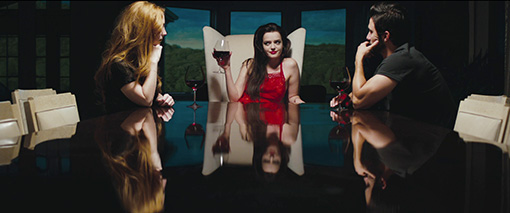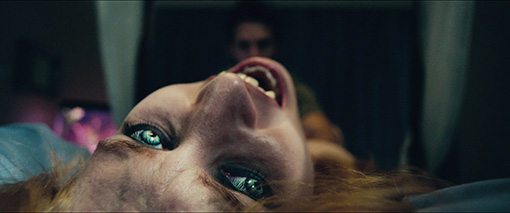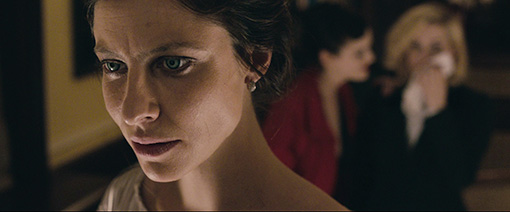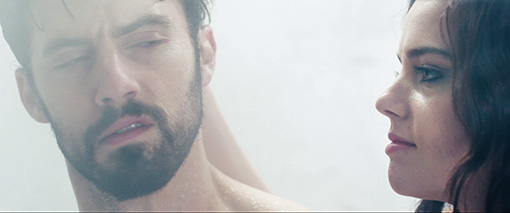|
Djuna is a vampire. We know this early on, not because of what she does but something she says. She has, she informs a good-looking new hook-up named Paolo, a condition that makes her sensitive to daylight. Back in the 1930s this would have probably meant little, but after ninety years of vampire movies we know in a heartbeat exactly what that signifies. Of course, it does help that the film in which this exchange takes place is being openly promoted as a vampire movie.
Paolo is first attracted to Djuna when they make eye contact in a video store. He, of course, doesn't realise she is a vampire, and we all know what that means – either he'll find out in time and run like the wind or he'll try to get into her knickers and suffer a quick and bloody death. But that's not what happens here, at least not in the expected sense. Paolo wants Djuna and Djuna wants Paolo; the problem for them both is that Djuna fancies Paolo badly enough not to want to kill him or turn him into a creature of the night, but that's how it works with vampire sex. She thus pushes him away but the attraction is too strong and she finally decides to tell Paolo just what she is. He doesn't really buy it, despite the blood drawn in an earlier (and inventively realised) doorway snog. To convince him she's for real, Djuna has him chain her to the bed and get busy with foreplay, which prompts her to undergo a physical transformation that leaves him in no doubt of the truth of her claim. This, you might think, is where he decides to leave. Instead he unchains her and allows her to bite him so that he too will become a vampire and the pair can be together, which is actually rather a neat play on traditional vampire lore. Djuna introduces Paolo to a vampire sub-culture comprised almost entirely of privileged sophisticates, whose nominal matriarch is successful stage actress Xenia. All seems to be going well for this nocturnally contented couple, right up until the point when Djuna's troublesome vampire sister Mimi turns up on their doorstep looking to stay for a couple of weeks.

Kiss of the Damned is a vampire movie in which the vampirism is a component of the story instead of its driving force, adding bite to a tale of familial contentment threatened by the arrival of the family's black sheep. And Mimi really does pose a credible threat, a walking billboard for the dark pleasures of dangerous sex who you just know is going to target Paolo sooner or later. The surprise is that our Paolo really is devoted to Djuna and soon comes to share her dislike of Mimi. But Mimi's wanton behaviour and almost adolescent need to push boundaries and outrage her peers not only plays havoc with her sister's happiness, but starts to threaten the safety of the whole vampire community.
Writer-director Xan Cassavetes was previously responsible for the excellent documentary Z Channel: A Magnificent Obsession, which charted revolutionary programmer Jerry Harvey's transformation of the titular cable channel into the go-to place for Los Angeles film enthusiasts in the early 1980s. How appropriate then that for her first dramatic feature, she has drawn inspiration from films that she first saw when they were screened by that channel, specifically the French 60s vampire films of Jean Rollin and his contemporaries. But despite a US poster that beautifully apes those of genre movies from the 60s and 70s (see the right-hand column – click on it for a larger image), this is no style-aping homage, but a distinctly modern work that draws inspiration from the eroticism and focus on character relationships of Rollin's films. This European influence is perhaps most evident in the casting of French actresses Joséphine de La Baume, Roxane Mesquida and Anna Mouglalis in the key roles of Djuna, Mimi and the matriarchal Xenia. All three are spot-on, as is Milo Ventimiglia in a pleasingly low-key way as Milo. Hell, even the supporting roles are engagingly cast here, which intermittently allows Cassavetes to put the narrative on hold and let her characters just sit and talk without risking audience impatience.

And Kiss of the Damned has style. Oh it definitely has that, in Cassavetes' canny camera placement and the unforced pacing and her direction of her actors, coupled with Tobias Datum's intimately framed scope cinematography and Steven Hufsteter's unsettling score. Intriguing from the off as a character drama (Djuna's bolt-from-the-blue attraction to Paolo literally hits her like a punch in the stomach), the vampire components are organically incorporated into the narrative and are at their most effective when suggested rather than shown, in Paolo's distracted glance at an exposed throat at a party, or the unfussy manner with which the vampires construct their everyday lives around the hours of darkness. The more traditional motifs of the genre are wisely rationed, but are smartly staged when the story requires them. This is particularly true of the sequence in which a sexually adventurous couple who have been lured by Mimi to the house for a threesome subsequently become her prey – as she chases down her second victim, her superior speed and agility is alarmingly suggested without recourse to reality-busting CG effects.
Kiss of the Damned is a film that slowly seduces rather than going for the throat. There's nothing particularly revolutionary about its story or execution, but its focus on character and the everyday aspects of vampire existence, coupled with Cassavetes' assured direction and embracement of the eroticism that for so long was confined to the subtext, really does give it a distinctive edge. It's a rare genre film in which women rather than men are both central to the drama and the power base of the vampire community. And despite not being dominant, the vampire component really does transform the drama, colouring relationships and amplifying the threat that Mimi represents. Yet her arrival also raises an intriguing question, one acknowledged by actress Roxane Mesquida on this very disc: in this gentrified subculture, with its cocktail parties and glasses of prime quality synthetic blood, is the predatory Mimi the only one who has not forgotten what it actually means to be a vampire?
A solid and unsurprisingly spotless 2.40:1 transfer that at first seemed to me to lack punch and have weak black levels in the darker scenes, of which there are many – a quick tweak of the brightness on my oh so carefully calibrated plasma TV, however, and the levels were spot on. Although not reference quality, the detail is still good in the darkness of night and very good when the light levels are more generous. Colours tend to be toned down or heavily tinted at night, but the image really shines in the film's only sequence set in bright sunlight, which I'd love to talk about but can't without delivering a massive spoiler (though I will reveal that it makes superb use of something as simple as a cigarette being raised into frame). There is evidence of what looks like digital grain in some scenes, but I'm guessing this is down to the source material.

The DTS-HD 5.Master Audio 5.1 surround track is very clearly recorded and seductively mixed, although is very front-weighted. Sound effects and music are especially well rendered, from the bass thump of the night-club techno tracks to the unsettlingly off-kilter throbs of Steven Hufsteter's score.
Audio Commentary by writer-director Xan Cassavetes
Cassavetes' commentary on the Z Channel: A Magnificent Obsession DVD was an exuberant and information-packed delight, although part of the fun there came from the energy generated by her interaction with her fellow filmmakers and movie enthusiasts. Her solitary turn here is a more sedate affair, though is still a most worthwhile listen and littered with interesting titbits about the making of the film. Areas covered include the contribution of her collaborators, what first inspired the project, the influence of European horror films of decades past, the importance of the actors' body language and elements that were shaped by personal experience. Her memories of working with agents are entertaining ("I remember there being a lot of coke"), and her defiant response to being told by others what they thought she should shoot brought a smile to my face: "You don't need to tell me what I think is good," she states with just a hint of annoyance. "It may not fit into some official rule book. Good."
Interview with Xan Cassavetes (7:50)
Essentially a seriously condensed version of the above, as much of the content here is covered in the commentary in more depth, though Cassavetes does reveal here that she doesn't audition actors and instead picks them because she recognises something in them that makes her want to work with them.
Interview with Joséphine de La Baume (9:50)
Actress Joséphine de La Baume (who plays Djuna) talks about her character, her first meeting with Cassavetes, the above mentioned doorway scene, and provides a considered analysis of the relationship Djuna and Mimi.

Interview with Roxanne Mesquida (7:13)
Actress Roxanne Mesquida (who plays Mimi) kicks off by describing Cassavetes as one of the coolest people she has ever met, then goes on to reveal that she researched her role by looking at Expressionist paintings – particularly Edvard Munch's Vampire – and watching Carl Dreyer's seminal 1932 Vampyr. She recalls that the shooting of the street sex scene caused them some problems with the NYPD, and that lodging in the house in which the film was shot became so boring that she lived for when filming would start again.
AXS TV Interview with Milo Ventimiglia (5:17)
American actor Milo Ventimiglia talks about what attracted him to the project, about relationships and the concept of love at first sight and restoring the genre's lost romance. He even describes the film as a romantic movie with a side of vampire. Three times.
AXS TV Interview with Roxanne Mesquida (6:48)
Despite some duplication of the interview above (quite a bit, actually), there is still enough new stuff here to make it worth a listen. Mesquida assures us that in real life she's actually very shy but had no problem with the nudity and sex scenes because Mimi wouldn't be scared of showing her body, and she wanted to commit one hundred percent to the character.
Also included are the well assembled Redband Trailer (2:31) and Greenband Trailer (2:30). The running times are virtually identical because it's effectively the same trailer twice but with different coloured cards at the start.
It's actually hard to nail just what it is that makes Kiss of the Damned a standout film in the mire of mediocre modern vampire movies. It breaks no new ground and even embraces some of the genre's most well-worn iconography (vampires are socially well connected and throw their jaws open and change eye colour before an attack), but the marriage of 60s genre eroticism and romanticism to a distinctly modern aesthetic gives birth to a work that feels rooted in neither period and is all the fresher for it. Eureka's Blu-ray sports a typically strong transfer and some useful extra features (the commentary is especially welcome), and thus has to come recommended.
|